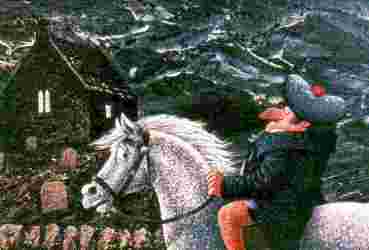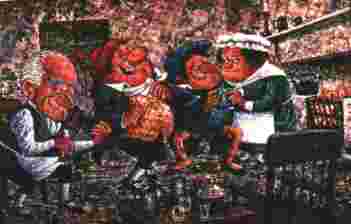Robert Burns interest in Scots song never flagged, and some of his best songs are the product of the period when he was at Ellisland. The quantity of his production here was not very great, but the quality is high. One need only mention Auld Lang Syne and John Anderson, My Jo among the songs, and, among the non lyrical poems, Tam o' Shanter.
Tam o' Shanter was written in 1790 for Captain Grose, the antiquary, and first appeared in Grose's Antiquities of Scotland, a work "chiefly meant to illustrate and describe the ancient castles and monasteries of Scotland." "The Antiquarian and the Poet," were unco pack and thick thegither.
Robert requested of Captain Grose, when he should come to Ayrshire, that he would make a drawing of Alloway-Kirk, as it was the burial-place of his father, and where he himself had some claim to lay down his bones, when they should be no longer serviceable to him; and added, by way of encouragement, that it was the scene of many a good story of witches and apparitions, of which he knew the Captain was very fond. The captain agreed to the request, provided the poet would furnish a witch-story, to be printed along with it.
Tam o'Shanter duly appeared in the second volume of the Antiquities, published in 1791; it was included as a long footnote to Captain Grose's description of Alloway Church.
This church, the footnote begins, is also famous for being the place wherein the witches and warlocks used to hold their infernal meetings, or sabbaths, and prepare their magical unctions; here too they used to amuse themselves with dancing to the pipes of the muckle-horned Deil. Diverse stories of these horrid rites are still current: one of which my worthy friend Mr. Burns has here favoured me with in verse.
The plot of Tam o' Shanter is genuine folklore. "This poem is founded on a traditional story," and gives three witch stories connected with Alloway Kirk, of which two are claimed to be authentic, and of the third that though equally true, it is not so well identified as the two former with regard to the scene. The second of these three anecdotes was the story of Tam o' Shanter, and it is interesting to compare Burns's prose summary with the poem which he made of it.
Here is his first account of the story, in his letter to Grose.
On a market-day, in the town of Ayr, a farmer from Carrick, and consequently whose way lay by the very gate of Alloway kirk-yard, in order to cross the river Doon, at the old bridge, which is about two or three hundred yards farther on than the said gate, had been detained by his business till by the time he reached Alloway it was the wizard hour, between night and morning.
 Though he was terrified with a blaze streaming from the kirk, yet as it is a well known fact, that to turn back on these occasions is running by far the greatest risk of mischief, he prudently advanced on his road. When he had reached the gate of the kirk-yard, he was surprised and entertained, through the ribs and arches of an old gothic window which still faces the highway, to see a dance of witches merrily footing it round their old sooty blackguard master, who was keeping them all alive with the power of his bagpipe. The farmer stopping his horse to observe them a little, could plainly descry the faces of many old women of his acquaintance and neighbourhood.
Though he was terrified with a blaze streaming from the kirk, yet as it is a well known fact, that to turn back on these occasions is running by far the greatest risk of mischief, he prudently advanced on his road. When he had reached the gate of the kirk-yard, he was surprised and entertained, through the ribs and arches of an old gothic window which still faces the highway, to see a dance of witches merrily footing it round their old sooty blackguard master, who was keeping them all alive with the power of his bagpipe. The farmer stopping his horse to observe them a little, could plainly descry the faces of many old women of his acquaintance and neighbourhood.
How the gentleman was dressed, tradition does not say, but the ladies were all in their smocks; and one of them happening unluckily to have a smock which was considerably too short to answer all the purpose of that piece of dress, our farmer was so tickled that he involuntarily burst out, with a loud laugh, "Weel luppen, Maggy wi' the short sark!" and recollecting himself, instantly spurred his horse to the top of his speed.
I need not mention the universally known fact, that no diabolical power can pursue you beyond the middle of a running stream. Lucky it was for the poor farmer that the river Doon was so near, for notwithstanding the speed of his horse, which was a good one, against all odds he reached the middle of the arch of the bridge, and consequently the middle of the stream.
The pursuing, vengeful hags were so close at his heels, that one of them actually sprung to seize him: but it was too late; nothing was on her side of the stream but the horse's tail, which immediately gave way to her infernal grip, as if blasted by a stroke of lightning; but the farmer was beyond her reach.
However, the unsightly tailless condition of the vigorous steed was to the last hours of the noble creature's life, an awful warning to the Carrick farmers, not to stay too late in Ayr markets.

Tam O'Shanter features on my CD of Burns poems
The Greatest Poems in the World.
To read more about this and hear an excerpt.
Click Here.
To return to Tam o'Shanter - the poem
Critical Analysis of Tam o'Shanter
|